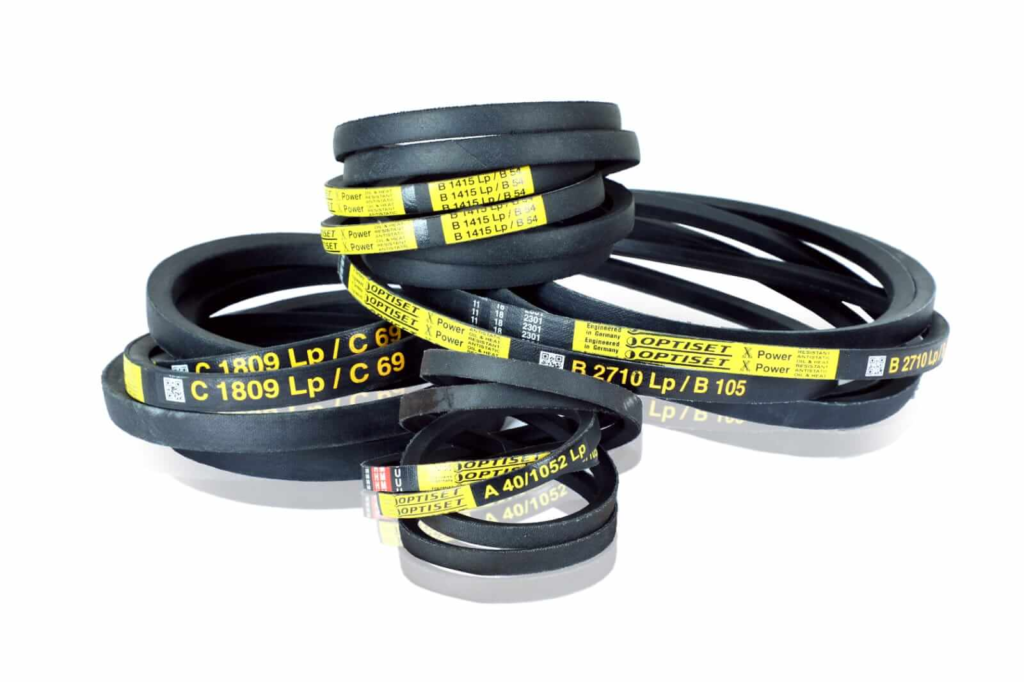Introduction
Machines aren’t running? You’re in a problem! The issue might be related to the V-belt, but no worries, as that can easily be replaced—if only you know how the size is measured. An industrial V-belt of the wrong size installed on your machine could malfunction and even raise safety concerns. Let’s ensure your fix goes smoothly by learning how V-belt measurement is done for an accurate replacement.
Key Takeaways
- V-belts are essential for efficient power transmission in various engines and machines.
- Used widely in automotive, industrial, HVAC, and agricultural sectors.
- Accurate measurement and selection are critical for machine safety and functionality.
- Made from high-quality polymers and reinforced with polyester or steel cables for durability.
- Require periodic inspections for wear and proper tensioning to maximize lifespan.
- High manufacturing and quality control standards ensure reliability and performance under demanding conditions.
Uses of V-Belt
Automotive Applications of V-Belts
V-belts find many uses in the automotive industry. The reliability, effectiveness, and indispensable driving of power into generally rightly attached attachments of a vehicle’s engine, like alternators, water pumps, power steering pumps, air conditioning compressors, etc., make sure that vehicles run smoothly and, more importantly, safely.
Industrial Equipment
They find massive applications in various industrial uses, including conveyor systems, lathes, milling machines, and other kinds of heavy equipment. Among all the means of transmitting substantial power, V-belts are unsurpassed while maintaining high-grade efficiency and strength.
Farm Machinery
Assist farmers in efficiently and effectively running their machines. The belts are used as drives for most of the essential components used in operations in tractors, combine harvesters, and other farm machinery. V-belts are relatively robust; therefore, they suit well under the harsh conditions that may be met during farm operations.
HVAC Systems
They also play important roles in heating, ventilation, and air conditioning. They will transmit all the needed driving power to fans, blowers, and compressors, giving top performance to these machines. V-belt strength guarantees a constant turnout of climate control and supply within both residential and industrial applications.
How V-Belts Are Made
Materials Used
V-belts are generally manufactured from high-quality polymers and high-tenacity polyester cable cords. Such materials provide the necessary tensile strength flexibility, and resistance against wear and abrasion. Some developed V-belts use high-tensile steel cables in the manufacturing process to attain unrivaled strength and load carrying.
Manufacturing Process
Mixing – The raw rubber is mixed with the reinforcing fibers to get a compound.
Forming – The rubber compound is produced in the form of a long cylindrical shape.
Curing – This formed belt shall be vulcanized to further improve strength and elasticity.
Cutting and Finishing – This belt will be cut to any required specific size and finished to exact specifications. Heat stretching and length stabilizing in the process allow for excellent length stability characteristics and shock-absorbing capacity.
Quality Control
Under manufacture, the V-belts are attributed to goodness in quality against the view. This takes into consideration check-off matters of uniformity, strength, heat resistance, and abrasion resistance. These control assurance measures ensure that every single belt has reliable work in the mode of operation for which it has been intended. At Jigna Sales Corporation, every process of the manufactured product passes under Hawk Eyes to ensure that products of both national and international quality standards are delivered.
Selecting and Maintaining V-Belts Pro-tips
- Selection: Choose a V-belt that is only sufficient for your machinery; there are variable specifications of load-carrying capacities under different operating environments. At Jigna Sales Corporation, V-belts are manufactured and supplied with a wide range of heights and widths. All these are covered under their standard codes like A, B, C, D, and E.
- Maintenance: V-belts can be subjected to periodic inspection for visible wear, such as cracking, fraying, or stretching. Also, ensure that they have proper tensioning and alignment to maintain them at maximum lifetime. Protective V-belts with wrapping of fabric or elastomeric materials protect enhancing the resistance of the belt toward heat and oil when used in small places for high-performance purposes.
Conclusion
V-belts find essential applications in automotive engines, industrial machinery, and HVAC systems. Their versatility and ruggedness in operational efficiency make them quite indispensable in many industries. Jigna Sales Corporation gives the finest V-belts backed by experience and quality. Theirs is a truly rugged construction—innovative in design with high-tensile steel cables and flexible rubber to ensure dependability in power transmission through the toughest industrial situations. Believe in their expertise to ensure smooth and efficient operations of your machinery.
So, choosing Jigna Sales for all of your V-belt requirements ensures that you have equipped yourself with the best quality belts at a fair price, backed by highly efficient customer service and technical expertise. Do contact Jigna Sales Corporation today, stating your requirement of V-belts, and experience dealing with the most reliable and trusted partner in this domain.



